Taiwan Fighter Jets Chase Away Chinese Sukhois After US Navy Plane Flies Over Island

KEY POINTS
- Taiwan Air Force jets chase away Chinese Sukhoi fighters from island's airspace
- U.S. Navy C-40A Clipper transport aircraft flew over Taiwan airspace
- U.S. military has increased its Freedom of Navigation Patrols through Taiwan Strait
The skies over Taiwan have been a busy place in recent days as Chinese Sukhoi Su-30 Flanker fighter jets were given verbal warnings by Taiwanese Air Force fighter jets to leave the airspace before forcefully driving them out of the area. According to Taiwan's Ministry of Defense, the aerial altercation had occurred to the southwest of the island Tuesday (June 9).
Another presence in the sky may have been a factor in the Chinese Flankers’ decision to willingly leave. Earlier, a U.S. Navy C-40A Clipper passenger transport aircraft flew an extremely unusual route over Taiwan's western coast.
The C-40A, a military version of the Boeing 737-700C passenger airplane, was detected by spotters using online flight tracking software. The flight appeared to leave Kadena Air Base on the Japanese island of Okinawa and then headed southwest toward Taiwan. It then passed near Taipei on Taiwan's northern tip before heading south along the coast.
The Clipper's route took it through actual Taiwanese airspace, where U.S. military aircraft rarely goes, and then it continued south into the South China Sea, then to U-Tapao Airport in Thailand. After departing Thailand, it headed to the island of Guam in the South Pacific, a strategic U.S. Territory.
China has also kept busy in the South China Sea to the southeast of Taiwan. The People's Liberation Army (PLA) has been conducting major exercises, some with its new aircraft carrier, the Shandong. The exercises are seen as a signal, with Taiwan the likely recipient of the message.
Beijing has openly stated its desire to reunify Taiwan under Chinese Communist control using force if Taiwan's President Tsai Ing-Wen makes a formal move to declare independence.
Any doubt about China’s intentions over Taiwan can be put to rest, according to a War Zone feature in The Drive online newsletter. It says the PLA has a highly accurate mockup of Taiwanese President’s Office Building, as well as one representing the Ministry of Foreign Affairs building, and other full-scale urban structures built in the PLA’s largest land training facility at Zhurihe, located in Inner Mongolia.
President Tsai was re-elected in a landslide victory earlier this year. Her inauguration speech included statements that Taiwan would move to further distance itself politically from the mainland.
If Tsai’s comments were not enough to raise Beijing’s hackles, her strong and close relationship with U.S. President Donald Trump's administration certainly has. Taipei has recently secured unprecedented arms deals with the U.S for new, advanced Block 70 variants of the F-16C/D Viper fighter jet. Beijing has called this a "red line" issue in past statements.
The U.S. military has increased its Freedom of Navigation Patrols (FONOP) through the Taiwan Strait, sending both ships and planes through the area as a demonstration of the United States' ongoing commitment to Taiwan.
© Copyright IBTimes 2025. All rights reserved.





















